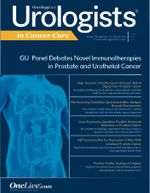Publication
Article
ADT Increases Risk for Depression in Elderly Men With Localized Prostate Cancer
Author(s):
Although androgen deprivation therapy has a survival benefit for patients with high-risk and locally advanced prostate cancer, it is associated with substantial safety concerns, and mixed data exist regarding whether it causes clinically significant depression.
Paul Nguyen, MD
Although androgen deprivation therapy (ADT) has a survival benefit for patients with high-risk and locally advanced prostate cancer, it is associated with substantial safety concerns, and mixed data exist regarding whether ADT causes clinically significant depression. A new population-based study published in the Journal of Clinical Oncology sought to explore this possible association.1
Using the Surveillance, Epidemiology, and End Results (SEER) Medicare-linked database from 1992 to 2006, researchers identified a total of 78,552 men aged ≥65 years with stage I, II, or III prostate cancer, of whom 33,882 (43%) received ADT within 6 months of diagnosis. Patients with a psychiatric diagnosis in the prior year were excluded.
Patients were categorized as receiving ADT (ADT+) if ADT was the primary therapy or if ADT was given alongside radical prostatectomy (RP) or radiation therapy (RT) before t0. Patients were categorized as not receiving ADT (ADT—) if ADT was not started from diagnosis through the follow-up period of 36 months after diagnosis. Primary treatment was defined as RP with or without ADT, RT with or without ADT, or ADT alone if initiated before t0 as identified through SEER-Medicare claims files, as previously described. To summarize, the ADT+ cohort was older at diagnosis, had more comorbidities, had shorter life expectancies, and had more high-grade disease (all P < .001)
The association between pharmacologic ADT and diagnosis of depression (primary endpoint) or receipt of psychiatric treatment (secondary endpoint) was analyzed using Cox proportional hazards regression. An additional secondary analysis explored the association between duration of ADT and the diagnosis of depression or receipt of psychiatric treatment.
Adjusted Cox analyses demonstrated a 23% increased risk for depression (adjusted hazard ratio [AHR], 1.23; 95% CI, 1.15-1.31) and a 29% increased risk for inpatient psychiatric treatment (AHR, 1.29; 95% CI, 1.17-1.41) among patients receiving ADT, and a nonsignificant 7% increased risk of outpatient psychiatric treatment (AHR, 1.07; 95% CI, 0.97-1.17).
All 3 of these parameters demonstrated a significantly increased risk with duration of ADT. For example, the risk of depression rose from 12% with ≤6 months of treatment, to 26% with 7 to 11 months of treatment, to 37% with ≥12 months of treatment.
“We know that patients on hormone therapy often experience decreased sexual function, weight gain and have less energy—many factors that could lead to depression. After taking a deeper look, we discovered a significant association between men being treated with ADT for prostate cancer and depression,” said senior author Paul Nguyen, MD, of Brigham and Women's Hospital, in a statement.
The ADT+ cohort was stratified by duration of therapy, defined as ≤6, 7 to 11, and ≥ 12 months. The cumulative incidence of depression increased by strata, from 6.1% to 7.6% to 8.0% with ≤6, 7 to 11, and ≥12 months of ADT, respectively, compared with an incidence of 5.2% in the ADT— cohort (P < .001). The incidence of inpatient psychiatric treatment increased by strata, from 2.4% to 3.0% to 3.3%, respectively, compared with 1.9% in the ADT— cohort (P < .001).
Nguyen added that the findings call for greater awareness of this under-recognized problem not only among patients, but also for clinicians, who need to be aware of the risk in order to recognize signs of depression and refer their patients to appropriate care.
Study authors wrote that these findings add to accumulating evidence around the major adverse event profile associated with ADT, and that the risk of psychiatric illness should be noted as a potential side effect when discussing ADT with patients. The possible adverse event also should be factored in when weighing the benefits and harms of ADT use in older men with intermediate-risk disease.
One study limitation noted by the researchers is that use of Medicare SEER data limited the scope to men aged ≥66 years at diagnosis, and thus, the results may not be applicable to younger men. Additionally, the relationship between depression and ADT treatment may be confounded by the fact that patients were older and had more comorbidity.
The researchers encouraged future studies focusing on interventions that could successfully reduce this risk and to examine whether particular subpopulations are at a higher risk, such as patients with a history of depression.
In the current study, older age, being unmarried, and having more comorbidity were associated with increased depression and psychiatric treatment. Although patients with recent psychiatric disease were excluded from the current study, other work has identified increased rates of depression among similar patients. These populations may be appropriate to target for early-depression screening or intervention after ADT initiation.
References
- Dinh KT, Reznor G, Muralidhar V, et al. Association of androgen deprivation therapy with depression in localized prostate cancer [published online April 11, 2016]. J Clin Oncol. doi:10.1200/JCO.2015.64.1969.
- National Comprehensive Cancer Network. (2016). NCCN guidelines, version 2.2016: Prostate cancer. https://www.nccn.org/professionals.










